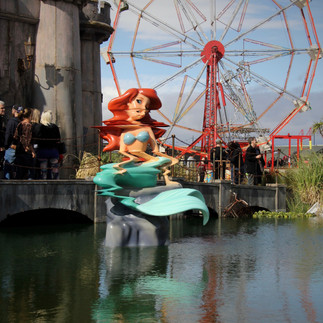Stepping into a Twisted Fantasy: Banksy's Dismaland
- Luke Stoffel

- Oct 31, 2015
- 2 min read
Updated: Oct 26, 2023
Dismaland - Bristol, United Kingdom
Photography by Lucas Stoffel can be licensed on Shutterstock and Getty Images

Dismaland photo by Luke Stoffel - Fine art prints available on Etsy.
In 2015, the enigmatic street artist Banksy unveiled a dystopian theme park, Dismaland, effectively jolting the coastal town of Weston-super-Mare into the global spotlight. With its glaring grey castle, distorted sculptures, and deliberately dismal performances, Dismaland was far from your usual theme park. This temporary art project, erected in a derelict lido, offered a morose and satirical commentary on consumerism, environmental decay, and a plethora of other societal issues, swiftly becoming an international sensation.
The entrance to Dismaland held no illusions about the bleakly satirical journey ahead. Gloomy attendants, purposely unenthusiastic and unhelpful, welcomed visitors into a world where the sparkle of typical amusement parks was ruthlessly stripped away. This was a realm where traditional expressions of joy were substituted with thought-provoking, often unsettling, installations and exhibitions from over 50 artists across the globe.

Dismaland photo by Luke Stoffel - Fine art prints available on Etsy.
The crumbling Cinderella Castle, one of Dismaland’s key visuals, offered a grim portrayal of the fate of princess fantasies and fairy-tale endings. Inside, a crash scene: Cinderella's pumpkin carriage, surrounded by a horde of paparazzi snapping away, highlighting the media's relentless scrutiny and society's fascination with celebrity tragedies.
Yet, despite its melancholic aura, there was something almost magnetic about Dismaland. The dismal park sparked vigorous debates and discussions, encouraging visitors and onlookers to question, to think, and to challenge the status quo. Banksy's darkly imaginative installations, such as the remote-controlled boats crowded with migrants or the killer whale leaping from a toilet into a plastic pool, wove a provocative narrative that seamlessly blended fantasy with harsh reality.
Dismaland photo by Luke Stoffel - Fine art prints available on Etsy.
While Dismaland was ephemeral, dismantled after just five weeks of operation, its impact lingered far beyond its physical existence. It drew in over 150,000 visitors, generating not only a significant economic boost for the area but also igniting conversations on the societal issues spotlighted through its morose exhibitions.

Dismaland photo by Luke Stoffel - Fine art prints available on Etsy.
Banksy, through Dismaland, demonstrated the potent capacity of art to not merely decorate spaces but to infiltrate minds, stirring reflections on societal norms and expectations. Dismaland was more than a parody of a theme park; it was a stark, thought-provoking mirror held up to modern society, a defiant reminder of the dissonance between our consumer-driven world and the dismal realities that underpin it.
In a world increasingly dominated by digital experiences, Dismaland underscored the undying relevance and potency of physical art spaces. It served as a stark reminder that art, in its myriad forms, continues to be a powerful vehicle for social commentary, capable of resonating across borders, sparking dialogue, and perhaps, instigating change.





















Comments